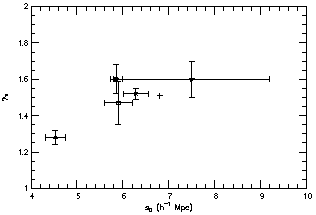


3.3 Correlation Function
The two-point correlation function, formally equivalent to the PS, has
been the most widely used statistics to quantify galaxy
clustering. Analyzes of magnitude-limited samples have led to
consistent results between nearby surveys (e.g., SSRS2) and those
probing volumes more than five times larger and adopting different
survey geometry and sampling strategies (e.g., Stromlo-APM, LCRS). A
summary of these results is shown in Figure 3, where
the redshift
correlation length s and the slope  of the best-fit power
law derived from different samples are compared (e.g.,
Willmer et al. 1998,
and references therein). As can be seen there is a
remarkable agreement among the optical surveys, except for the CfA2
where peculiar motions near the Great Wall are important. In
particular, note that the good agreement between the values found for
a wide range of volumes is in marked contrast with what would be
expected if the galaxy distribution were a fractal. In some cases the
relatively small differences between redshift and real space
correlations on intermediate scales (~ 10 h-1 Mpc)
immediately suggest, as in the case of the SSRS2, a low value of
of the best-fit power
law derived from different samples are compared (e.g.,
Willmer et al. 1998,
and references therein). As can be seen there is a
remarkable agreement among the optical surveys, except for the CfA2
where peculiar motions near the Great Wall are important. In
particular, note that the good agreement between the values found for
a wide range of volumes is in marked contrast with what would be
expected if the galaxy distribution were a fractal. In some cases the
relatively small differences between redshift and real space
correlations on intermediate scales (~ 10 h-1 Mpc)
immediately suggest, as in the case of the SSRS2, a low value of  =
=
 0.6 / b < 1
(e.g.,
Willmer et al. 1998).
0.6 / b < 1
(e.g.,
Willmer et al. 1998).

|
Figure 3. Comparison of the correlation length and slope of the two-point correlation function in redshift space computed for different optical and IR samples. The samples considered are: CfA2-slice (filled triangle), SSRS2 (filled square), LCRS (star), Stromlo-APM (open squares), ORS (cross), IRAS (open triangles) (for details see Willmer et al. 1998). |
While galaxy clustering at the present-epoch seems to be well quantified, at least for low-order statistics, work is now concentrated in measuring its evolution and interpreting the results within the hierarchical clustering framework. Until recently such studies were hindered by large uncertainties as they had to rely on the observed two-point angular correlation function and models for the clustering evolution and redshift distribution. However, the availability of an increasing number of samples (CFRS, CNOC2) spanning a large redshift baseline, will soon provide the means to directly measure the evolution of the correlation function and disentangle the effects of cosmology and galaxy evolution (e.g., Kauffmann et al. 1998). Preliminary results from CFRS indicate a strong evolution of the clustering amplitude with redshift up to z ~ 0.6 (Le Févre et al. 1996b). This is at variance with more recent results of Carlberg et al. (1998) based on the CNOC2 data, who find a much weaker evolution. Results from very high redshift surveys are also becoming available (Steidel, this proceedings) and the time evolution of clustering as a function of galaxy properties is within reach.